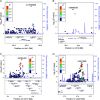Immunochip meta-analysis in European and Argentinian populations identifies two novel genetic loci associated with celiac disease
- PMID: 31591516
- PMCID: PMC7028987
- DOI: 10.1038/s41431-019-0520-4
Immunochip meta-analysis in European and Argentinian populations identifies two novel genetic loci associated with celiac disease
Abstract
Celiac disease (CeD) is a common immune-mediated disease of the small intestine that is triggered by exposure to dietary gluten. While the HLA locus plays a major role in disease susceptibility, 39 non-HLA loci were also identified in a study of 24,269 individuals. We now build on this earlier study by adding 4125 additional Caucasian samples including an Argentinian cohort. In doing so, we not only confirm the previous associations, we also identify two novel independent genome-wide significant associations at loci: 12p13.31 and 22q13.1. By applying a genomics approach and differential expression analysis in CeD intestinal biopsies, we prioritize potential causal genes at these novel loci, including LTBR, CYTH4, and RAC2. Nineteen prioritized causal genes are overlapping known drug targets. Pathway enrichment analysis and expression of these genes in CeD biopsies suggest that they have roles in regulating multiple pathways such as the tumor necrosis factor (TNF) mediated signaling pathway and positive regulation of I-κB kinase/NF-κB signaling.
Conflict of interest statement
The authors declare that they have no conflict of interest.
Figures




References
Publication types
MeSH terms
Substances
Grants and funding
LinkOut - more resources
Full Text Sources
Medical
Research Materials
Miscellaneous

